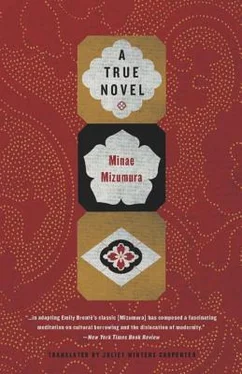Minae Mizumura - A True Novel
Здесь есть возможность читать онлайн «Minae Mizumura - A True Novel» весь текст электронной книги совершенно бесплатно (целиком полную версию без сокращений). В некоторых случаях можно слушать аудио, скачать через торрент в формате fb2 и присутствует краткое содержание. Год выпуска: 2013, Издательство: Other Press, Жанр: Современная проза, на английском языке. Описание произведения, (предисловие) а так же отзывы посетителей доступны на портале библиотеки ЛибКат.
- Название:A True Novel
- Автор:
- Издательство:Other Press
- Жанр:
- Год:2013
- ISBN:нет данных
- Рейтинг книги:4 / 5. Голосов: 1
-
Избранное:Добавить в избранное
- Отзывы:
-
Ваша оценка:
- 80
- 1
- 2
- 3
- 4
- 5
A True Novel: краткое содержание, описание и аннотация
Предлагаем к чтению аннотацию, описание, краткое содержание или предисловие (зависит от того, что написал сам автор книги «A True Novel»). Если вы не нашли необходимую информацию о книге — напишите в комментариях, мы постараемся отыскать её.
A True Novel
The winner of Japan’s prestigious Yomiuri Literature Prize, Mizumura has written a beautiful novel, with love at its core, that reveals, above all, the power of storytelling.
A True Novel — читать онлайн бесплатно полную книгу (весь текст) целиком
Ниже представлен текст книги, разбитый по страницам. Система сохранения места последней прочитанной страницы, позволяет с удобством читать онлайн бесплатно книгу «A True Novel», без необходимости каждый раз заново искать на чём Вы остановились. Поставьте закладку, и сможете в любой момент перейти на страницу, на которой закончили чтение.
Интервал:
Закладка:
4. Three White Pebbles
BEFORE I GO into the rest of my time in Chitose Funabashi, I feel I should expand a bit on the three families—the Shigemitsus, the Saegusas, and the Utagawas. None of them are well known. Their family histories have no direct bearing on Taro’s story. All the same, slowly learning about their past—and how they got where they were—had a profound meaning for someone like me, though I cannot say the process wasn’t sometimes sad or painful.
In fact, learning about those families was my education.
I always knew there were some people in the world who were “privileged.” But you can know something without having any real understanding of it. Only after many long years of observing these people with my own eyes did I come to understand why they were the way they were. And only then could I understand myself, and, tracing it back, why my grandparents and my mother and Uncle Genji were the kinds of people they were. I gradually came to see that though we’re given only one chance to live our lives, we’re at the mercy of something larger than the abilities and personalities we’re born with, something that is beyond our control.
LET ME START with the two Seijo-area families, the Shigemitsus and the Saegusas. I only came to know their story so well because of the Shigemitsus’ maid, the Demon, who never tired of telling it.
In the Shigemitsus’ summer house in Karuizawa there was a north-facing room with a wooden floor where the maids had their meals. It was known by its English name, the servants’ hall . Every Sunday, the two families had a big meal together, which they also referred to in English as Sunday lunch , and when this was over, we maids got time off and went back to the servants’ hall , where we sat at the table and poured ourselves some green tea. There were three of us: the Demon from the Shigemitsus, Chizu from the Saegusas, and me from the Utagawas. The Demon and I would knit, while Chizu leafed through a weekly magazine. Generally, the Demon wasn’t talkative, but when we were alone together, she became quite a storyteller.
It turned out that she came from a farming family in Kagoshima, on the southern island of Kyushu. She’d worked for the Shigemitsus for more than thirty years, from the time when Yayoi’s mother married into the family. The Demon was unlike anyone I’d ever met: a combination of loyal retainer in a Kabuki play and maidservant in a nineteenth-century European novel. She also had the distinction of being the only maid who got to go with the Shigemitsus to London—she of course traveled separately on the ship, in steerage.
My first summer there, I couldn’t make much sense of what she told us. I felt she was disappointed that I wasn’t the enthusiastic audience she hoped for. Still, I was definitely a better listener than Chizu, who sat there, her heavy legs crossed, flipping through the pages of her magazine. And with each summer, the names of the places, schools, and companies the Demon mentioned made more sense to me. The more I understood, the more interested I became, so in the end I suppose I did become something of an ideal audience for her.
One thing the Demon emphasized first and foremost was that the Shigemitsus were socially in a different league from the Saegusas. According to her, the Shigemitsus belonged to the same social rank as the Andos—that family I was taken to when I wore stockings for the first time. The Saegusas didn’t count as a “good” family. Nor did the Utagawas, for that matter, but she was less critical of them, perhaps because they weren’t as close to the Shigemitsus and had no intention of climbing up the social ladder. “Those sisters want to be just like the Shigemitsus, down to the way they walk,” the Demon whispered scornfully. She resented not only the Saegusa girls’ social aspirations but their natural sparkle and talents too.
For the Demon, there were astonishingly few “good” families. The forebears of those “good” families had become prominent in the late nineteenth century, when Japan was modernizing: they had been involved in the founding of major enterprises, they had some experience living in Europe or the United States, and some had belonged to the peerage before the war. Their descendants still lived in only the best Tokyo neighborhoods, where daimyo and their retainers used to live in the olden days, and they all sent their children to the same elite schools. As a result, they knew who the other prominent families were, or were connected with them in one way or another. This exclusive set also seemed to share the experience of having lost a great deal after the war’s end, and of having their estates in Tokyo or a villa in some quiet location outside the city confiscated by the American authorities during the Occupation. People in any other kind of family were nobodies.
The Shigemitsus, whose forebears had for generations been chief retainers to the daimyo of the Settsu domain near what is now Osaka, played a major role after the Meiji Restoration. Yayoi’s grandfather was a managing director of Nihon Yusen, the most important shipping company then, as well as the Sanyo Railroad; and her father—who had studied economics at the Imperial University and spent two years at Oxford—joined the Mitsubishi Corporation, where he became head of the company’s London office. Yayoi’s mother’s side was even grander. One of her ancestors, a samurai of the Satsuma domain in Kyushu, gained recognition for helping to bring about the Restoration itself and, with the onset of modernization, founded several businesses, including Yokohama Bank. Her grandfather had achieved the rank of baron or something similar. Since then, her father had been a member of the House of Peers and sent all his children to Peers School. Every male in the family had become a prominent statesman or entrepreneur. Just listening to the family history was a little overpowering.
The Saegusas couldn’t hold a candle to them. As far as the Demon was concerned, they were simply commoners: none of them had been involved in starting a major corporation, none of them had studied in the West, none of them had belonged to the peerage. The elder Mr. Saegusa, Grampy, was the second or third son of a sake brewer up north in Niigata. He graduated from the Tokyo Higher Commercial School and found a position at Tokyo Electric. After World War I, when he was still in his mid-twenties, he’d had sufficient business sense, with a fairly modest outlay of capital, to walk away with a handsome profit on the rice market. He made it through the Great Depression unscathed. Then, after making a killing on fertilizer futures, he started a company that produced canvas rice bags. All of his ventures went well. As for the sisters’ mother—a great beauty in her youth, apparently—her people were landowners in Niigata, and she met her future husband through local connections. Her parents themselves left Niigata for Tokyo, so she grew up in the capital and was a thorough city girl, having gone to a high-toned Christian school for young women.
“They’re new money,” the Demon sniffed. In the countryside where I grew up, sake brewers and landowners had real status; in her eyes, the Saegusas were nothing but upstarts. Only years later did it occur to me that the older aristocratic families—descendants of Heian nobility and Edo daimyo—might have looked down on the Shigemitsus in much the same way.
It was only because of being neighbors that the two families met. Both had moved to Seijo in order to send their children to the progressive school there. These days, Seijo is a fancy suburb full of movie and television personalities and real estate profiteers, but it was originally developed by high idealists who hoped to raise children with a sense of freedom, close to nature, so that, once grown up, they’d help bring a new Japan into being. These idealists moved all the way from the center of town out where there was no gas or running water, to a place where flickering fireflies and croaking frogs ruled the night. Of course, these pioneers not only had high ideals but also had the means to back them up.
Читать дальшеИнтервал:
Закладка:
Похожие книги на «A True Novel»
Представляем Вашему вниманию похожие книги на «A True Novel» списком для выбора. Мы отобрали схожую по названию и смыслу литературу в надежде предоставить читателям больше вариантов отыскать новые, интересные, ещё непрочитанные произведения.
Обсуждение, отзывы о книге «A True Novel» и просто собственные мнения читателей. Оставьте ваши комментарии, напишите, что Вы думаете о произведении, его смысле или главных героях. Укажите что конкретно понравилось, а что нет, и почему Вы так считаете.












